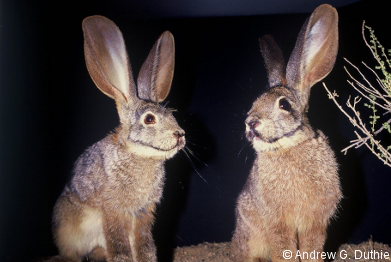
EDGE mammal number 10, the riverine rabbit (Bunolagus monticularis), lives in an area of the Karoo Desert in South Africa’s Cape Province that is ideal for agriculture, and unfortunately has now lost 50-80% of its habitat to farming. The species is finding it almost impossible to recover and is in desperate need of conservation attention.
This rabbit is the only species in the whole Bunolagus genus, within the Leporidae family, which includes jackrabbits and hares. Riverine rabbits have distinctly large ears, and a unique dark brown stripe running from the corner of the mouth and across the cheek towards the base of the ear, making them look a bit like the ‘joker’ from Batman.
Riverine rabbits are endemic to South Africa and are habitat specialists, occupying only dense vegetation along the seasonal rivers of the Karoo desert. The species’ livelihood depends on the fine, loose earth of the floodplains, the only soil in the area suitable for making stable burrows. The rabbits eat wild flowers and leaves from the trees on the riverbanks, and supplement their diet with grass during the wet season.
During the day the riverine rabbits avoiding predators by resting in shallow dens underneath bushes. Individuals are solitary and have a polygamous mating system, but unusually for rabbits, females have only one or two young each year. They have a short lifespan of three years, which means that only about four offspring are produced during each rabbit’s lifetime.

A number of organisations have joined to form the Riverine Rabbit Conservation Project. The project has identified locations of the rabbit and its optimum habitat. Since almost all the rabbits are found on privately owned farmland, the species’ survival depends on environmentally friendly farming practices, so landowners are being encouraged to adopt these.
So far, three riverine rabbit conservancies have been established in the Karoo Desert. The Endangered Wildlife Trust’s Riverine Rabbit Working Group was established in 2003 and now coordinates all conservation efforts. A captive breeding programme was attempted in 1987 but had to be abandoned due to high mortality of rabbits in captivity and the fact that they were introduced into a national park that had no suitable habitat.
If you’d like to get involved in conservation yourself and want to help us, please install the FREE Instant Wild App and help EDGE identify animals via camera trap photos from around the world.
HAPPY EASTER!
